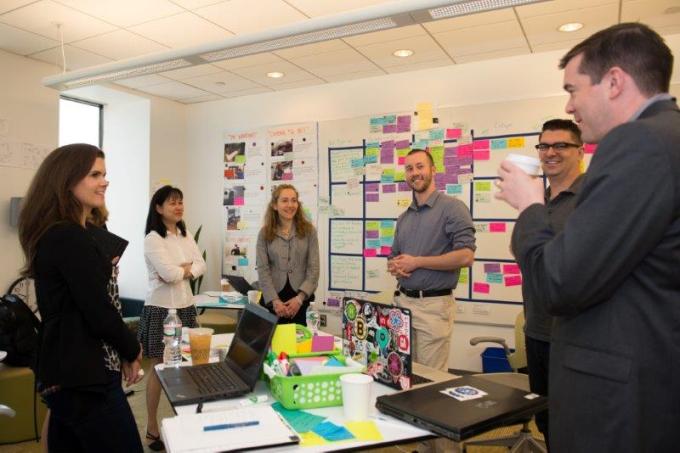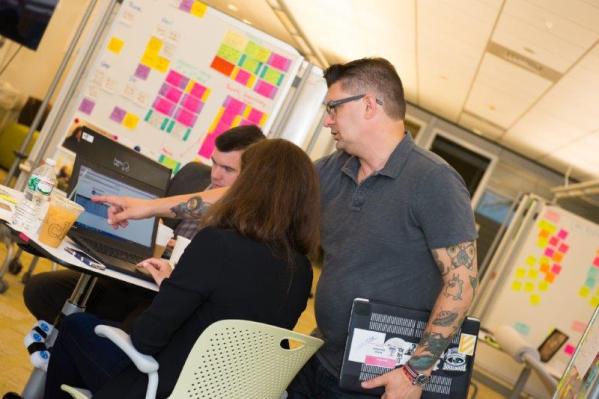Change doesn’t come easily to large organizations. Over time they have established a firm set of core business processes to give them the structure to manage massive workforces, which makes sense, but it also means they lack the agility of smaller companies.
They have created systems to provide safe and effective ways of doing business, which protects companies from chaotic decision making and running willy nilly toward every market whim.
This inability to pivot can be a weakness in the current economic environment which requires independent and creative thinking and the ability to react quickly to changing markets.
Big companies by their nature simply aren’t prepared for that kind of approach.
Now, smart executives are seeing the limitations of this strategy and are looking for ways to turn the battleship to find new ways of engaging with customers and doing business.
One method companies have begun employing has been through building internal incubators and labs as innovation engines. Typically these projects have a goal beyond pure experimentation, and at their best they develop new products and ways of working that get absorbed into the organization at large.
Developing New Ways Of Thinking
The lab or incubator provides a way to institutionalize this approach and carve out a pocket of innovation that’s separate for the most part from internal processes. That doesn’t mean necessarily that there is no process, but it’s a process defined with the purpose of building a new generation of tools and to instill new ways of thinking and creating that eventually reach across the entire organization.
“What every company needs today is scale or agility. The Coca-Cola company is one of most scaled companies on the planet. We need to learn more about agility,” David Butler VP of innovation at Coca-Cola told me in February. On the flip side, startups know about agility, but don’t have any understanding of how to scale. Butler believes by incubating startups in-house, Coke can bring these two requirements together and both parties can learn from one another.
You have to have that center of the business that makes it run, but you need something that sits further away from the center so it doesn’t get sucked into the organizational vortex, explained Vanessa Colella, managing director and global head of venture investing at Citi Ventures.
“In a large organization, there is a center of gravity to the business. When you are close in you are necessarily pulled by the gravitational force. There is more focus on how do we do things that are near in,” she explained in a conversation last Fall.
“We found at Citigroup that if we sit further away, we can bring outside innovation in.” She makes it clear though that you still have to bring that innovation inside eventually where it can benefit the whole organization. “Those things can’t be in a different solar system. They have to come together,” she explained.
It’s great thing when you have to get into this mode because you’re [constantly] iterating and delving deeper into what customers want and need Vanessa Colella
She said, the challenge is that there is constant change now. From a digital perspective, that means you can’t just make one change and think you’re done. She’s sees this constant push from market forces as positive because it forces you to continually look for new ways to engage your customers.
“It’s great thing when you have to get into this mode because you’re [constantly] iterating and delving deeper into what customers want and need,” Colella said.
All In Service Of The Customer
 Ultimately all of this innovation is about one thing: servicing the customer, says Sean Belka svp and director of Fidelity Labs. “Our goal is how do we identify ideas that solve important customer problems — and how do we apply design thinking + agile + lean startup methods to make that happen.”
Ultimately all of this innovation is about one thing: servicing the customer, says Sean Belka svp and director of Fidelity Labs. “Our goal is how do we identify ideas that solve important customer problems — and how do we apply design thinking + agile + lean startup methods to make that happen.”
Fidelity has been running Fidelity Labs for many years as a place to experiment with different ways of doing business inside the larger company. Today one of its main focuses is offering an entirely new way of approaching customer problems through experimentation and iteration. Its ultimate goal remains developing products that are useful to their core audience of investors.
Fred Leichter, SVP and head of the Design Thinking program at Fidelity Labs is a Stanford Fellow, who attended its d. School. This had a huge influence on his approach.
“The most important job is figuring out what is the customer problem we’re solving for,” Leichter said. This could involve experimenting with a dozen low fidelity prototypes, all with the goal of figuring out if they are solving a real problem in a meaningful and creative way. They understand they could start with a clear premise and proposed solution and find out they were way off base. That’s part of the learning process.
The Labs working under this design process has projects in various stages of development from very early experimentation to one that is fully developed and ready to incorporate into the main product family. The former is called FidSafe, a digital safe deposit box for all your important documents. What’s great about it, is that it solves a big problem for customers, but it also acts as a catalyst for many of the other solutions that are in progress inside the Labs. What’s most important though is that all of the projects are completely focused on the customer and eventually the hope is graduating from the Lab and into the company.
Jerry Wolfe, who runs a company called Vivanda, which started as a small experimental project inside of the spice giant, McCormick says starting small inside a lab or incubator lets the company see the advantages of innovating and opening new digital channels to customers. That’s why these labs and incubators are so popular. They allow a safe way to introduce this kind of thinking inside an organization.
“Don’t start with ‘we need a digital transformation initiative.’ That has a high rate of failure,” he explained. He says look for that small bit of success. In his case it was Vivanda’s FlavorPrint app. For Fidelity Labs, it’s FidSafe. Whatever it is, if you start small, you can build from there and begin to build the type of innovative thinking your company needs to survive moving forward.
